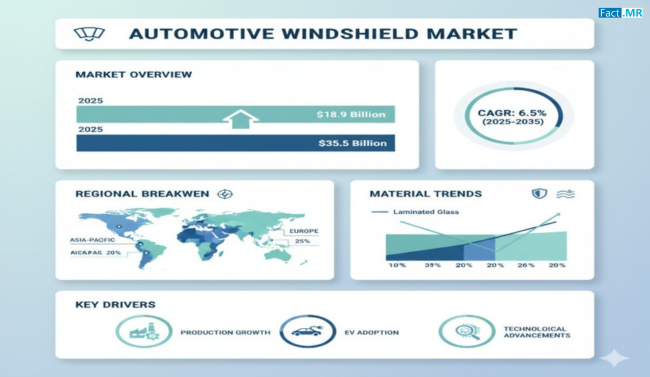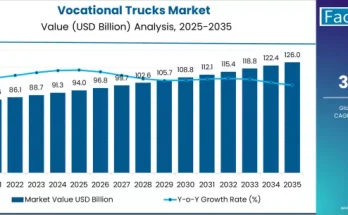The automotive windshield market is evolving rapidly as vehicle manufacturers prioritize safety, comfort, and technological integration. Windshields are no longer just transparent panels; they have become integral components of vehicle safety systems, noise reduction, climate control, and advanced driver-assistance systems (ADAS).
Rising safety standards, consumer demand for enhanced driving experience, and the proliferation of smart vehicles are driving innovation in windshield materials, coatings, and functionalities. As the automotive sector embraces electric, autonomous, and connected vehicles, windshields are increasingly designed to support sensors, heads-up displays, and other digital technologies.
Market Overview:
Automotive windshields are typically made from laminated glass, offering durability, impact resistance, and clarity. Innovations in materials include ultra-lightweight composites, acoustic glass, and solar-reflective coatings to enhance performance and energy efficiency.
The market is driven by safety requirements, including impact protection, shatter resistance, and UV filtering. Windshields now serve multiple functions beyond visibility, including integration with rain sensors, cameras, lane departure warnings, and collision avoidance systems.
Manufacturers are focusing on premium and functional windshields that improve vehicle aesthetics, reduce noise and vibration, and support smart features. Production advancements, such as automated glass cutting, laminating, and coating technologies, are enhancing quality, efficiency, and customization options.
Regional Insights:
North America leads in adoption due to stringent automotive safety regulations, widespread presence of high-end vehicle manufacturers, and early integration of smart vehicle technologies. Consumer demand for advanced safety and comfort features further supports market growth.
Europe is another prominent market, driven by regulatory mandates for occupant safety, environmental sustainability, and energy-efficient vehicles. European automakers are investing in advanced windshield technologies, including acoustic and solar-protective glass.
Asia-Pacific is emerging as a high-growth region, fueled by rapid automotive production, rising consumer income, and increasing vehicle sales in countries such as China, India, and Japan. The region’s focus on electric and connected vehicles is driving demand for multifunctional windshields.
Latin America and the Middle East & Africa are gradually increasing adoption, supported by expanding automotive manufacturing, urbanization, and rising awareness of vehicle safety standards.
Innovations and Regulatory Trends:
Innovation in the automotive windshield market centers on materials, coatings, and technology integration. Laminated glass with enhanced acoustic, thermal, and UV-blocking properties is becoming standard in premium vehicles. Windshields integrated with heads-up displays, cameras, sensors, and ADAS functionalities are gaining traction.
Sustainability is also shaping the market, with manufacturers exploring energy-efficient coatings, lightweight materials, and recyclable glass. Smart coatings that reduce glare, improve scratch resistance, and support self-cleaning are attracting significant attention.
Regulatory trends are critical drivers, with authorities setting standards for impact resistance, visibility, UV protection, and integration with safety systems. Compliance ensures vehicle safety, legal adherence, and consumer confidence, and influences windshield design and materials across all vehicle segments.
Key Trends & Forecast:
The automotive windshield market is evolving around several notable trends:
- Integration with Smart Technologies: Windshields are increasingly supporting ADAS, heads-up displays, cameras, and sensors for autonomous and semi-autonomous vehicles.
- Enhanced Safety and Durability: Laminated, tempered, and multi-layered glass provide impact resistance, shatter protection, and occupant safety.
- Acoustic and Thermal Comfort: Acoustic glass and heat-reflective coatings reduce cabin noise and improve energy efficiency in vehicles.
- Lightweight and Eco-Friendly Materials: Reducing vehicle weight for fuel efficiency and exploring recyclable or sustainable materials is gaining prominence.
- Premium and Aesthetic Enhancements: Curved, tinted, and solar-protective windshields improve vehicle design, comfort, and visual appeal.
These trends highlight the market’s focus on combining safety, technology, sustainability, and aesthetics in automotive windshields.
Applications & End-Use Outlook:
Automotive windshields serve multiple applications across various vehicle types:
- Passenger Vehicles: Enhancing safety, comfort, and aesthetics, while integrating features like ADAS, heads-up displays, and UV protection.
- Commercial Vehicles: Providing durability, impact resistance, and clarity for buses, trucks, and delivery vehicles, while supporting safety compliance.
- Electric and Autonomous Vehicles: Acting as platforms for sensors, cameras, and displays necessary for autonomous driving functionalities.
- Luxury and Premium Segments: Advanced coatings, acoustic insulation, and smart features cater to high-end consumer preferences.
The multifunctional nature of automotive windshields ensures they play a critical role in vehicle safety, design, and technological integration.
Competitive Landscape:
The automotive windshield market is competitive, featuring global glass manufacturers, automotive OEMs, and specialized suppliers. Companies focus on R&D to develop advanced glass materials, coatings, and smart functionalities to differentiate their products.
Strategic partnerships with automakers, technology providers, and suppliers enable faster integration of innovative windshields in new vehicle models. Maintaining high-quality standards, compliance with safety regulations, and delivering multifunctional solutions are key strategies for sustaining market leadership.
Conclusion:
The automotive windshield market is poised for continued growth, driven by evolving safety regulations, consumer demand for comfort and smart features, and innovation in glass technologies. Windshields are increasingly multifunctional, combining safety, aesthetics, and technological capabilities to meet the needs of modern vehicles.
Manufacturers and suppliers that prioritize innovation, sustainability, and integration with digital vehicle systems will be well-positioned to capture opportunities in this dynamic and evolving market. Automotive windshields will continue to play a critical role in shaping safer, smarter, and more comfortable driving experiences worldwide.
Browse Full Report – https://www.factmr.com/report/13/automotive-windshield-market



